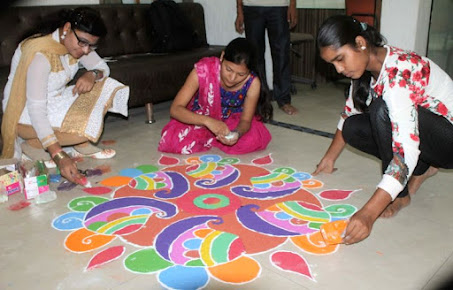Diwali today: Why there is a tradition of making Gharondas and Rangolis on Diwali
On the occasion of Diwali , the tradition involves not only the worship of Lord Ganesha and Goddess Lakshmi but also the embellishment of homes with 'Gharondas' (miniature houses) and rangolis, followed by their worship.
According to mythological beliefs, when Lord Rama returned to Ayodhya after completing fourteen years of exile, the residents celebrated his arrival by lighting lamps in their homes. This act symbolized the joyous atmosphere that filled Ayodhya once again with his return. This tradition contributed to the increased popularity of making miniature houses.
With the commencement of the Kartik month, people begin the cleaning of their homes. Concurrently, the construction of Gharondas begins. The term "Gharonda" is derived from the word Ghar, which means home and typically, unmarried girls commence the construction of Gharondas for Diwali at the beginning of the month.
Unmarried girls believe that creating these miniature houses will ensure the prosperity of their future homes. However, in many places, the tradition of making Gharondas is observed on the day of Diwali itself.
Common materials for decorating Gharondas include kulhads and earthen pots, which unmarried girls fill with sweets and snacks. The primary rationale behind this practice is that, in the future, when these girls go to their in-laws' house after marriage, they contribute to the household by providing a supply of grains.
Although the girls themselves do not use the filled grains, they share them with their brothers since the responsibility of protecting the house and bearing its burdens falls on the shoulders of men.
Playing with Gharondas brings great joy to girls, leading them to decorate the Gharondas as if they were their own homes. Various colored papers, flowers, and lamps are employed for the adornment of these Gharondas.
The main objective is to ward off darkness in their homes, ensuring that the entire house remains illuminated. In the modern era, the tradition of making Gharondas has evolved from single-storey to two-storey structures.
During Diwali, another tradition involves the making of rangoli within the house. Diwali festivities entail special attention to house decoration, and rangoli enhances the overall charm. Regardless of a house's beauty, if rangoli is omitted at the main entrance, the house's aesthetic appeal seems incomplete.
Typically, rangoli is made using rice, wheat, flour, paint, and abir, but the most exquisite rangoli is composed of flowers. Marigold and rose petals, along with harsingar flowers, are utilized for this purpose, not only imparting beauty but also symbolizing purity.








Comments
Post a Comment